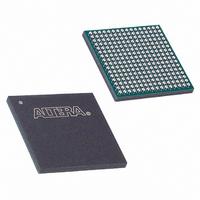EPM7512BFC256-7 Altera, EPM7512BFC256-7 Datasheet - Page 8

EPM7512BFC256-7
Manufacturer Part Number
EPM7512BFC256-7
Description
IC MAX 7000 CPLD 512 256-FBGA
Manufacturer
Altera
Series
MAX® 7000Br
Datasheet
1.EPM7256BFC256-7.pdf
(66 pages)
Specifications of EPM7512BFC256-7
Programmable Type
In System Programmable
Delay Time Tpd(1) Max
7.5ns
Voltage Supply - Internal
2.375 V ~ 2.625 V
Number Of Logic Elements/blocks
32
Number Of Macrocells
512
Number Of Gates
10000
Number Of I /o
212
Operating Temperature
0°C ~ 70°C
Mounting Type
Surface Mount
Package / Case
256-FBGA
Voltage
2.5V
Memory Type
EEPROM
Number Of Logic Elements/cells
32
Lead Free Status / RoHS Status
Contains lead / RoHS non-compliant
Features
-
Available stocks
Company
Part Number
Manufacturer
Quantity
Price
MAX 7000B Programmable Logic Device Data Sheet
8
The Altera development system automatically optimizes product-term
allocation according to the logic requirements of the design.
For registered functions, each macrocell flipflop can be individually
programmed to implement D, T, JK, or SR operation with programmable
clock control. The flipflop can be bypassed for combinatorial operation.
During design entry, the designer specifies the desired flipflop type; the
MAX+PLUS II software then selects the most efficient flipflop operation
for each registered function to optimize resource utilization.
Each programmable register can be clocked in three different modes:
■
■
■
Two global clock signals are available in MAX 7000B devices. As shown
in
either of the global clock pins, GCLK1 or GCLK2.
Each register also supports asynchronous preset and clear functions. As
shown in
to control these operations. Although the product-term-driven preset and
clear from the register are active high, active-low control can be obtained
by inverting the signal within the logic array. In addition, each register
clear function can be individually driven by the active-low dedicated
global clear pin (GCLRn). Upon power-up, each register in a MAX 7000B
device may be set to either a high or low state. This power-up state is
specified at design entry.
All MAX 7000B I/O pins have a fast input path to a macrocell register.
This dedicated path allows a signal to bypass the PIA and combinatorial
logic and be clocked to an input D flipflop with an extremely fast input
setup time. The input path from the I/O pin to the register has a
programmable delay element that can be selected to either guarantee zero
hold time or to get the fastest possible set-up time (as fast as 1.0 ns).
Figure
Global clock signal. This mode achieves the fastest clock-to-output
performance.
Global clock signal enabled by an active-high clock enable. A clock
enable is generated by a product term. This mode provides an enable
on each flipflop while still achieving the fast clock-to-output
performance of the global clock.
Array clock implemented with a product term. In this mode, the
flipflop can be clocked by signals from buried macrocells or I/O pins.
1, these global clock signals can be the true or the complement of
Figure
2, the product-term select matrix allocates product terms
Altera Corporation














